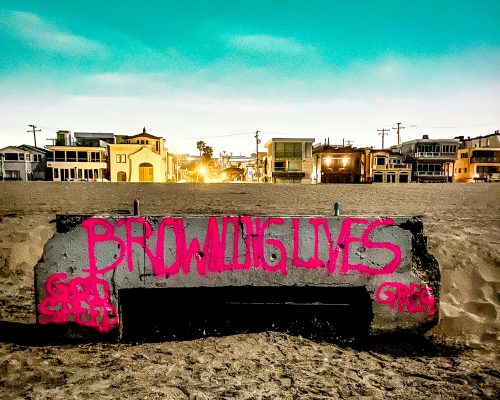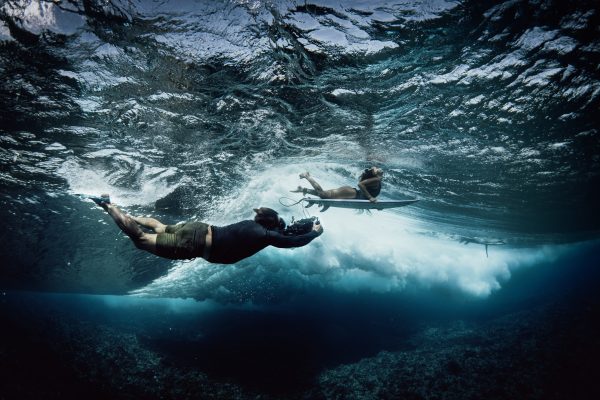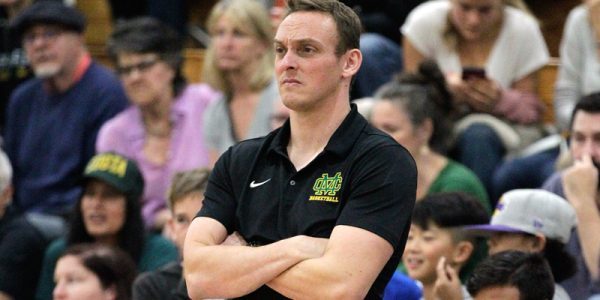by Kevin Cody
Greg Browning talks about the Redondo Breakwall with the knowledge and enthusiasm of an elite skier talking about his favorite mountain.
Breakwall is where a 14-year-old Browning confronted his fear of big waves. It’s where he established himself as a member of surfing’s Momentum Generation, commemorated in the early ‘90s, groundbreaking Taylor Steele surf videos.
Browning would follow Steele into a career as surf film maker. Browning’s credits include his own Drive Thru surf travelogs for Fuel TV and Fox Cable, and the Jamie O’Brien YouTube videos for Red Bull.
Breakwall is also where Browning’s surfing and video careers ended with a life-threatening accident in January 2023. It wasn’t the accident, but what caused the accident that has had lasting consequences.
On Saturday, April 27, Browning will be inducted into the Hermosa Beach Surfer Walk of Fame, along with friend and collaborator Mike Balzer, whose photographs landed Browning multiple surfing magazine covers. Hawaiian pro surfer David Nuuhiwa will also be inducted this year.
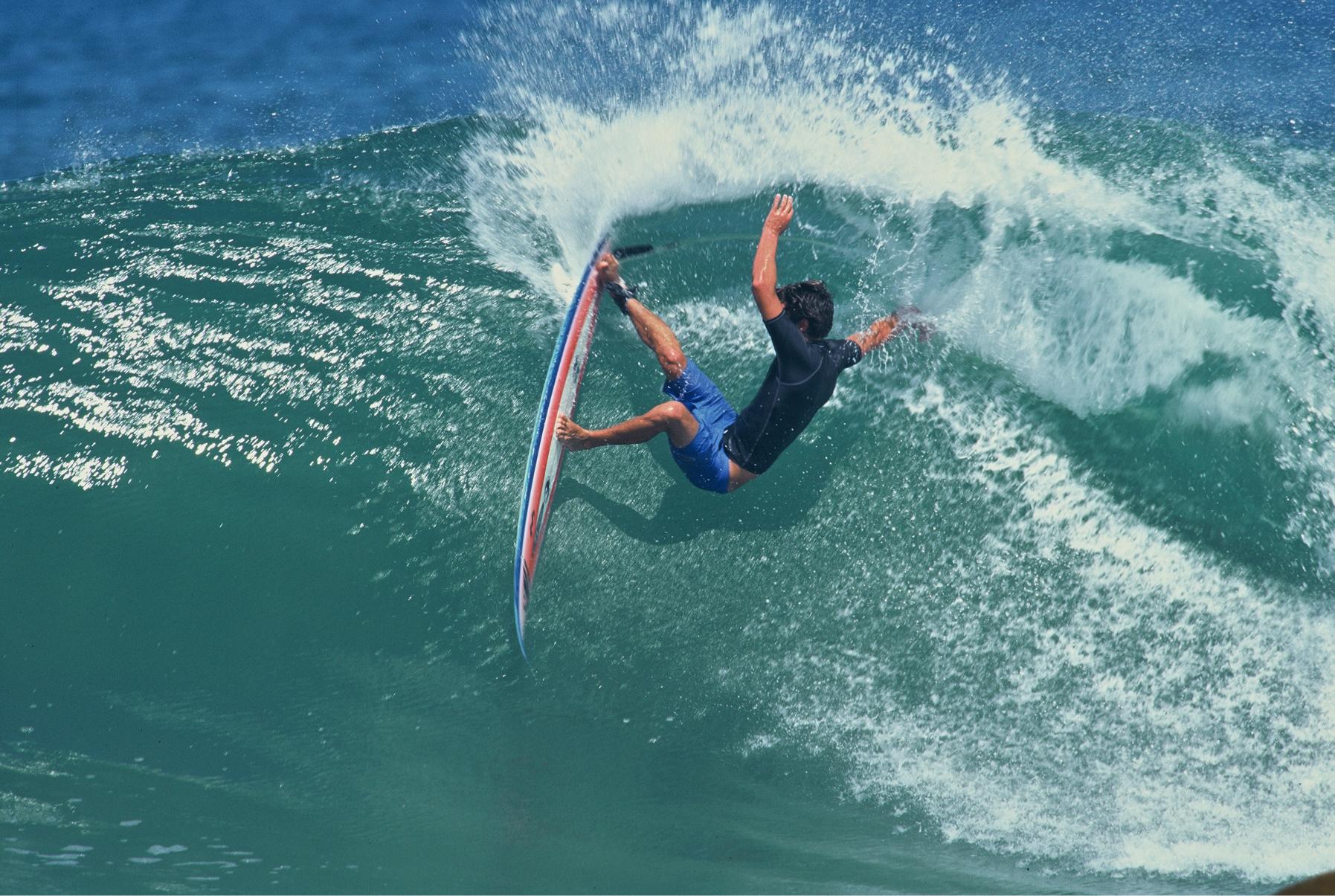
“The best seat in the house at Breakwall is off the north end of the Charthouse,” Browning said in a recent interview. “It’s in the middle, inside. It’s got a really good bounce to it.”
Like The Wedge in Newport Beach, the Breakwall wave jacks up when big north swells bounce off the north facing breakwall.
“The only problem with that wave is nine out of 10 times it closes out,” he said.
Browning’s knowledge of the Breakwall wave is matched by his decades deep knowledge of its best surfers, most of whom prefer to sit further out and closer to the Breakwall than Browning.
Browning is that rare athlete who genuinely celebrates rather than secretly envies competitors having a better day than he is. He hoots for whoever gets a good wave.
“If you’re not a goofy footer, it’s really hard to hold on to the outside waves,” Browning said. He is a regular foot surfer, which means he stands with his back to the Breakwall’s left-breaking waves.
“Scoots (Scott Johnson), and Angelo (Luhrsen), and his younger brother Luca can really read the bounce. Scoots has that classic style. He still has it today. Angelo has that Luhrsen tenacity from his dad Michael, and uncles Jude and James. Angelo is a hunter.”
Browning had been surfing big days at the Breakwall for nearly four decades on the day of his accident last January
His voice lacked its usual enthusiasm when he recalled that day, but neither was it solemn. It was all business, like he was directing a shoot.
“I’d spent the previous three days surfing 16th Street Hermosa, getting pitched on every wave. I knew something was going on, and you want to be at your best at Breakwall. But it was really good. Glassy, four feet. No one else was out. Just me and my son Parker.”
To avoid the punishing paddleout at the Breakwall, even the best surfers typically walk out along the rocks, past the break zone, before jumping in the water.
Browning always paddles out, hugging the channel next to the rocks and duck diving the sets.
“Mike Purpus told me when I was young what Hap Jacobs told him when he was young. If you can’t paddle out, you don’t belong out there,” he said.
“I caught three waves. I was having a good day, But on the fourth wave, when I tried to get up, my left arm gave out. I ended up taking the drop on my belly, and taking the lip on my head. I’m underwater thinking, what an idiot, when the board whacked me in the chin.”
Instagram censored the photo Browning posted of the injury for “violent or graphic content.” The nose of his board blew a hole like a gunshot wound, a quarter inch square hole, in the underside of his chin.
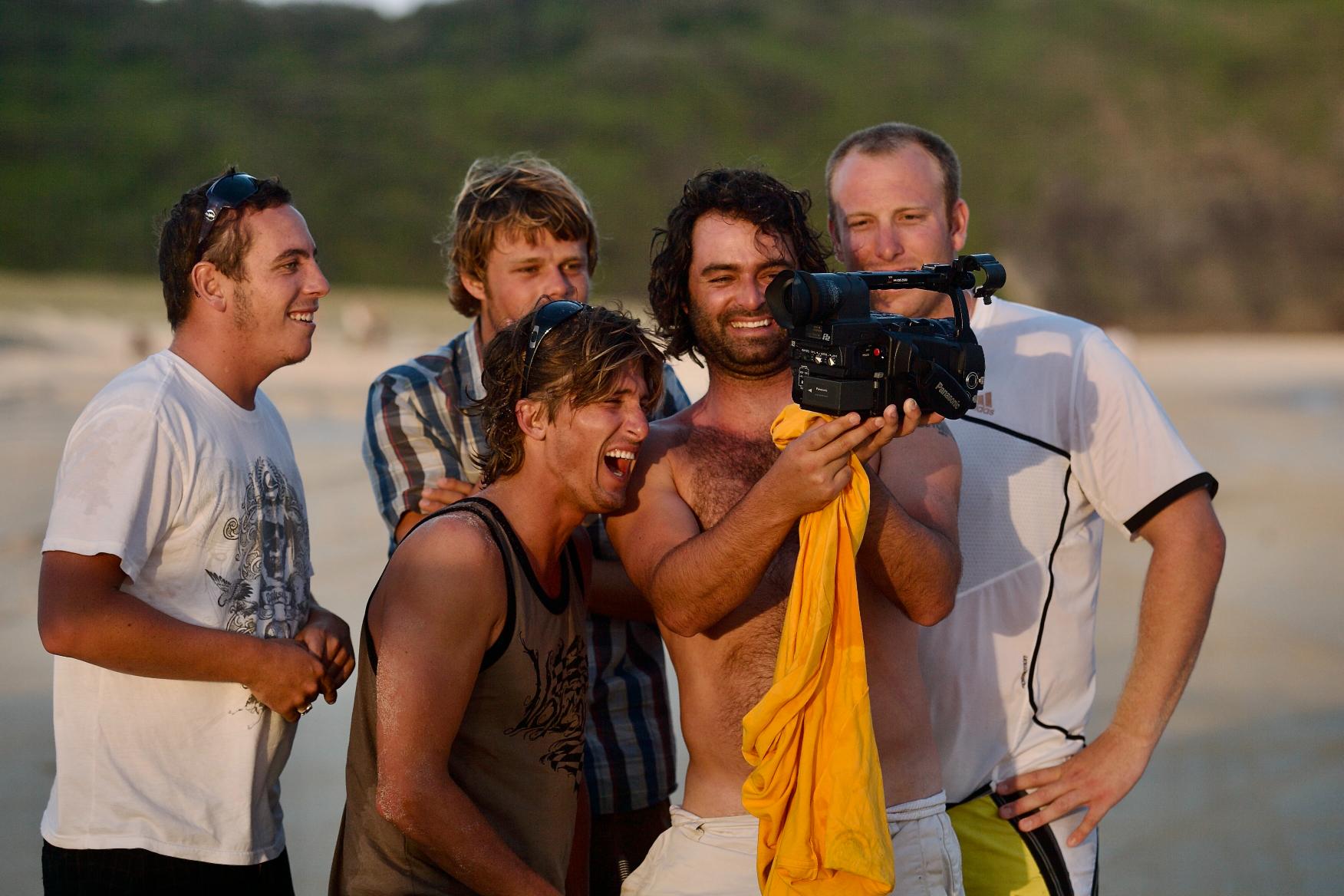
“When I was getting stitches, the doctor told me to see a neurologist,” Browning said.
He didn’t until after Tom Horton called Brad Thomas.
Horton is president of the South Bay Boardriders Club whose contests Parker competes in. Thomas is a Manhattan Beach orthopedic surgeon who specializes in fixing surfers’ and volleyball players’ shoulders. Thomas is also a surfer. In 2011 he won the 32-mile Catalina Classic Paddleboard Race.
Thomas found nothing wrong with Browning’s left arm, and nothing wrong when he checked for stroke and a brain tumor. He referred Browning to neurologist Laura Jong in Palos Verdes.
Dr. Jong told Browning if he was lucky he had MMAB(Methylmalonic acidemia), a treatable immunity deficiency disease. The other likely cause, she said, was ALS (Amyotrophic Lateral Sclerosis), or Lou Gehrig’s disease. The main symptom is muscle weakness. Medication and therapy can slow ALS’s progress, but there’s no cure.
On April 24, of last year, the day before his 49th birthday, Dr. Jong put Browning on a regiment of blood infusions, four hours a day, for five consecutive days, every two weeks, for three months.
Throughout the treatment, Browning’s condition worsened. He could make a fist, but not close his thumb. His legs felt wobbly, his voice developed a slight tremor. The diminishment in his fine motor skills had begun to affect his tongue.
On Aug 16 of last year, Browning saw an ALS specialist Dr. Richard Lewis at Cedars Sinai Hospital. Browning had ALS.
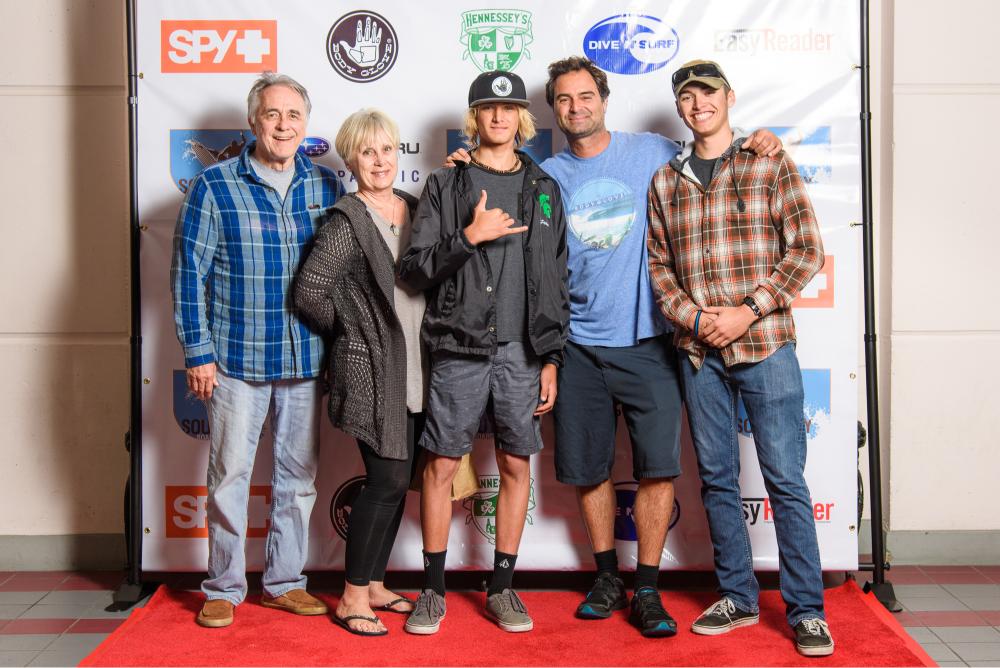
“Browning began surfing with his brother Jeff and best friend Jack Doolitlle. While surfing the south side of Hermosa Pier, they met Derek and Keith Brewer, with whom Greg later played on the same baseball team at Hermosa Beach Little League at Clark Stadium, across the street from where he lived.
Through the Brewers, Browning met Matt Walls. Though only a few years older, Walls babysat the Brewers. Walls also hung out at Clark Stadium.
“Clark Stadium was everyone’s babysitter,” Walls recalled. Like the Browning brothers, Walls was raised by a single mom.
Browning credits Walls’ invitation to the Brewers and him to surf at 16th Street as a pivotal point in his surfing career.
Hermosa’s best surfers surfed in front of the 16th Street storm drain, whose runoff creates a channel that forms left and right breaking waves.
“Purpus surfs here” was graffitied above the mouth of the storm drain.
Purpus remains the best surfer to have emerged from the South Bay.
His Encyclopedia of Surfing entry reads, “The only California surfer to compete regularly as a professional in the early and mid-’70s. Purpus was a five-time invitee to the Duke Kahanamoku Classic…”
Purpus commonly credited his surfing success to having learned in Hermosa. “The beach break is so bad, if you can surf here, you can surf anywhere,” he said.
Aside from the storm drain, another reason for 16th Street’s popularity was retired Panasonic engineer Howard Eddy.
Mark Kerley, one of the 16th Street crew, was a Hermosa cable installer in the early ‘80. During an installation at Eddy’s 16th walkstreet home, he noticed a Panasonic VHS camcorder. VHS was in its infancy. Kerley asked Eddy to video him and his friends surfing. Over the subsequent decade Eddy would record hundreds of hours of the 16th Street surfers.
Blackline Video recently digitized Eddy’s VHS tapes, and Browning and Walls have begun logging the tapes and posting them on Youtube.
Throughout their years at Redondo High, Browning and the Brewers would walk from their south Hermosa homes to 16th Street to surf. After school they would return to Eddy’s house, with Walls and other 16th Street surfers to review that morning’s video.
Walls recalled a day in the early ‘90s when they noticed Browning’s surfing had ratcheted up a level. Browning attributed it to his new Spyder board shaped by Dennis Jarvis. It was thinner and had more rocker than the wider, thicker boards everyone was riding.
“The next day, we all got new Spyder boards. That was when Dennis started getting the top pros to ride his boards,” Walls recalled.
“I attribute my contest success to watching those tapes and having the Brewers and Matt heckle me for kicking out and not going for the barrel,” Browning said.
Browning recalled on his first trip to Trestles with Steve Hoag, paddling out at the trail end. “Cottons was to the right and Uppers to the left. The trail end wasn’t a surf spot. But it had the best waves I’d ever ridden,” Browning recalled.
Browning and the Brewers entered their first contest at 13. It was a NSSA (National Scholastic Surfing Championship) at Malibu. All three advanced to the finals. Derick Brewer finished fourth, Browning 5th and Keith Brewer 6th.
in 1990, when he was 16, he won the NSSA South West Men’s Open. It was at the NSSA contests where he met Donavon Frankenreiter, Rob Machado and the Malloy brothers. After winning his division, he was named to the Men’s National Team.
Browning credits not only his surfing career, but also his video career to the Howard Eddy tapes.
“If Howard’s camera broke, he’d get the soldering iron out and show me how to fix it.
“Those days also taught me to stay locked in on the surfers, and not start shooting seagulls, and girls. If I missed Brewer or Walls on a good wave, they’d miss me when they were shooting and I was on a good wave.”
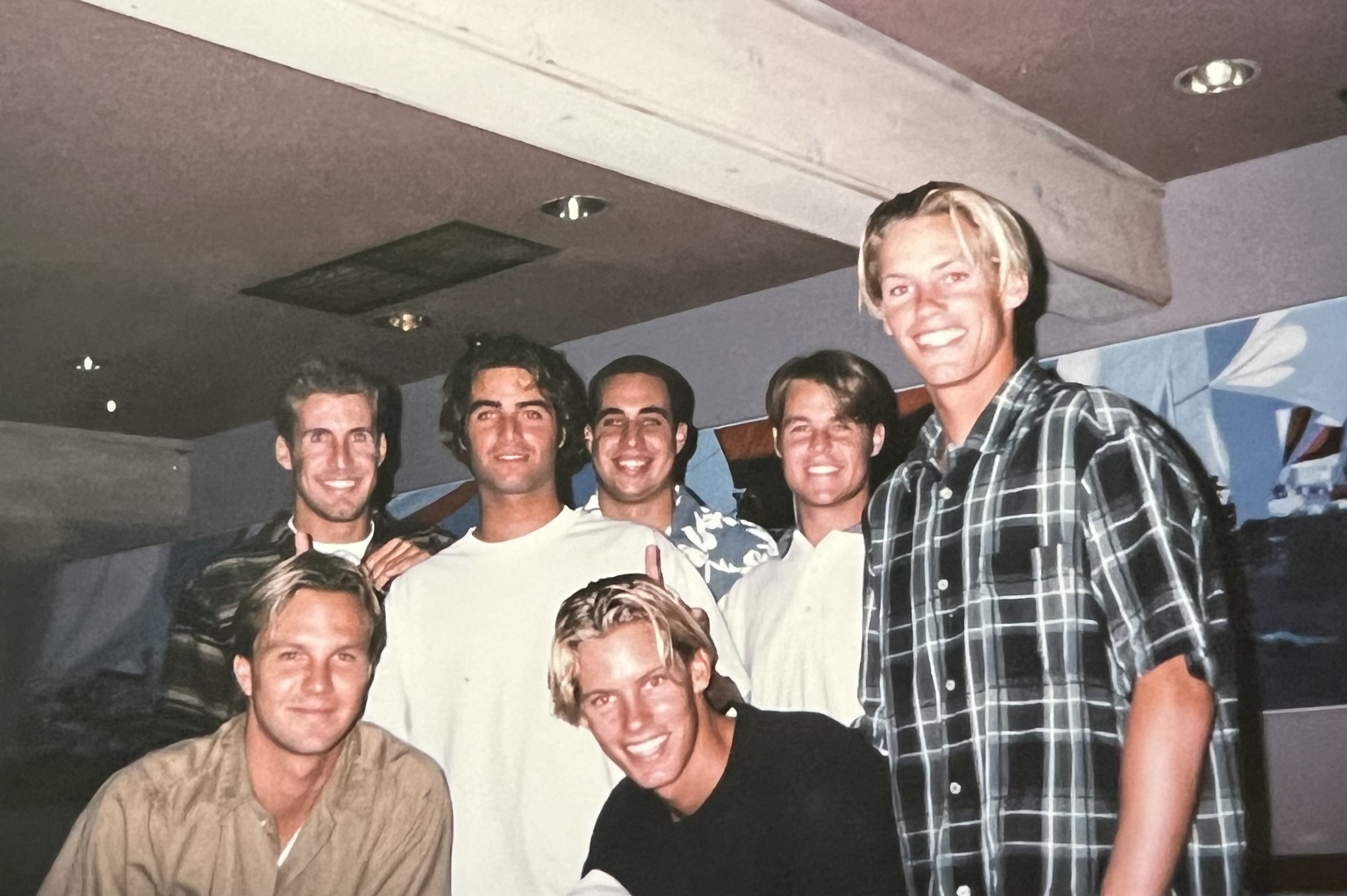
In high school Browning’s dad bought him an 8mm RCA camcorder. He started making films in a style that would subsequently be popularized by Jackass.
“I’d put the camera in a ziploc bag and jump from the roof of the bait shop at the end of the Hermosa pier.
“I’d toss the camera in the air just before hitting the water so the ziploc wouldn’t pop.
“Then I’d video my friends jumping.”
They jumped at night so the lifeguards wouldn’t stop them.
After Howard Eddy, Browning credited Body Glove for its role in his surfing career.
“They put me on their team when I was 14, and gave me a job when I was 24 and out of work with my first child, Drew. They’ve continued to support me to this day,” Browning said.
When he was a senior at Redondo, he competed on the Bud Pro Tour, founded by Body Glove CEO Robbie Meistrell.
“Most of the Bud Pro contests were in California, which meant I could compete professionally without having to travel to Hawaii, Europe, and South America, which I couldn’t afford,” Browning said.
“I had 42 absences my senior year at Redondo. On graduation day I was competing in a Bud Light contest in Oceanside. I drove home in the afternoon to walk, and drove back to Oceanside the next morning to compete,” he said.
The Bud Pro Tour had the further advantage of strengthening Browning’s friendships with the surfers who would become the Momentum Generation, among them Donavon Frankenreiter, Benji Weatherley, Shane Dorian, Rob Machado, and Taylor Steele.
“When guys flew in from Hawaii for the Bud Pro tour, they stayed with us,” Browning said.
Browning would appear in three, widely popular Steele videos including the 1993 Momentum II.
Friendships Browning made on the Bud Tour led to invitations to Hawaii’s North Shore. He was 15 on his first visit, over Christmas break.
“I stayed at Jack Johnson’s, whose family shared a yard with Peff Eick,” Browning said.
Johnson was a top ranked surfer before becoming a rock star.
Eick was a Manhattan Beach developer who had been a member of the Weber Surf team in the ‘60s. Browning knew Eick from hanging out after school at Competition Surf on Pacific Coast Highway, across the street from the Weber shop.
Eick entered surfing lore last year when Jack Johnson revealed during an appearance at the Hollywood Bowl that Eick taught him his first guitar chords.
Johnson then invited Eick to join him on stage to sing the song Eick had taught him, Jimmy Buffet’s “A Pirate Looks at Forty.”
During Browning’s second high school Christmas break in Hawaii, he slept in his car for two weeks in the Weatherly family’s driveway. On Christmas morning he fell asleep on his car horn, and forever after was known by Weatherly’s mother as “the boy who woke me at 3 a.m. on Christmas Day.”
Browning surfed Pipeline, Sunset and Waimea, “terrified out of my mind,” he said. “I was only staying for two weeks out of the year, which made no sense, because there might not be waves, and if there were, it wasn’t enough time to get comfortable in the line up.”
Browning’s professional career stalled, but his visibility grew, not only through the Taylor Steele videos, but through surf magazine covers shot by Mike Balzer.
Balzer shot for Body Glove.
Their first shoot together at the Redondo Avenues produced the photo for the month of October in the 1991 Surfing Magazine calendar.
“I’d call Mike every night to ask him to shoot in the morning, and if he didn’t answer I’d go knock on his door,” Browning said.
Their first Surfer magazine cover was the August 1997 issue. The photo was taken from the Manhattan Beach pier, and was actually two photos, depicting the start and finish of Browning’s signature front side snap.
“He put the board vertically up the face of the wave, at 12 o’clock,” Balzer said, “and then pushed down on the tail with his back foot, throwing a spray and bringing the nose to six o’clock. Greg started getting so many photos in the magazines that contest pros began complaining.”
Browning became known as a “photo slut” because contest surfers did not approve of maneuvers that weren’t landed. No one could tell from the photos if Browning was sticking the landings. In the beginning he wasn’t. But he learned to, and as a result, the contest surfers had to, also.
In breaking loose from the wave’s surface, Browning and the other freestyle surfers took their inspiration from street skateboarders bored by skate parks, and snowboarders bored with slaloming.

Following high school, Browning moved to San Diego to start an apparel company with Taylor Steele with the unfortunate name of Seventeen. After two years, the magazine Seventeen took notice, and threatened legal action, causing the company to fold.
Upon returning to the South Bay with his then wife, a young child and no job, Body Glove VP Ronnie Meistrell told him to call Body Glove team manager Scott Daley. Browning helped manage the team, which included videoing while Balzer shot stills.
“Mike taught me photography. I didn’t know anything about lighting and focus because video cameras did it all automatically. That time was the highlight of my career. I was getting paid to go on surf trips and hang out with my friends,” Browning said.
During this period he was also learning to edit video under Body Glove art director Mark Kawakami.
“I’d come back from trips to South Africa and I’d tell my brother Jeff how great Jeffreys Bay was and he’d say, ‘Yea, but what about the parties? Did you go on safaris? Did you film that? That’s what I want to see.’”
“I realized just shooting surfing was like going to Disneyland and just shooting the rides,” Browning said.
In explaining the success of his Drive Thru videos to Surfer Magazine, Browning said, “I realized when you go on a surf trip, what you remember isn’t the waves. It’s the people you go with, the people you meet, and all the things that go wrong.”
That’s when he had the idea for Drive Thru California, a surf video about a bunch of buddies going traveling together.
“There were no cell phones. Nobody knew what happens on surf trips,” Browning said.
It was reality TV before reality TV
“Donavon Frankenreiter, and Rob Machado, all these guys I knew from NSSA were in their prime. So I called them and said let’s rent an RV and go on a surf trip up the coast of California. They all said no. When you’re a top surfer, people are always calling with great ideas, and 99 times out of 100 nothing happens.
“So I called Taylor Steele, and he called them, and everyone jumped on board because Taylor had a track record of getting things done.
“On the first Drive Thru, I was the water cameraman, the second cameraman, producer, and one of the surfers. It was too much. On the second one I stopped being a surfer,” Browning said.
To save on parking fees, Browning backed the RV into parking places as close as he could to the car behind. Then he parked the Jeep they towed as close as he could to the front of the RV. When cops told him he had to pay the meter or move, he’d tell them he wanted to move, but he couldn’t until the car in front moved.
Donavon Frankenreiter and Benji Weatherly were the Abbott and Costello of the ensemble. After the third episode, Fuel TV underwrote the next 26 episodes, including Drive Thru Europe with Kelly Slater.
“We rode motor scooters through the gates of the Vatican at 5 in the morning,” Browning said.
“Drive Thru” became a victim of its own success. Fox bought it from Fuel TV.
“I was paying $200 for music rights. But when I said I was with Fox, bands wanted $10,000.”
Fox also wanted girls.
Browning wanted girls too, but he knew that wasn’t going to work.
“Put everyone in separate hotel rooms at night, and by the next morning they’ve hit reset. You lose the spontaneity and camaraderie,” Browning said.
“Five surfers sleeping together in an RV get testy. There’s no hiding. The nicest guys become dicks. The biggest dicks become nice guys. That was my favorite stuff to film,” he said.
After Fox bought Drive Thru, Browning returned to Body Glove.
In 2016, the Meistrell family sold Body Glove to Marquee Brands, a luxury marketing company whose other lines included Bruno Magli women’s shoes, Ben Sherman mens shirts, and Martha Stewart.
“They created a video department but after four months of waiting for something to shoot I left. I have to stay busy,” Browning said.
Jamie O’Brien, who had ridden for Body Glove, gave Browning’s name to Red Bull.
“Red Bull paid me to produce eight 15 minute YouTube videos of Jamie over the four month long winter season in Hawaii. I told Jamie we could do eight episodes in two weeks. So after the winter season, we went off on our own.”
JOB became one of the most popular videos on YouTube, with over one million subscribers.
“There were no scripts. We just looked for fun things to do. We traveled around the world, doing five shows in two weeks.
“Jamie is good in hectic situations. He’d paddle out at Pipeline on a five-foot-6 Skipper soft top. I’d swim out with fins and a camera, shitting in my pants.
“Jamie is one of the top three Pipeline surfers, along with Slater and John John Florence. But he’s underestimated because he doesn’t do contests,” Browning said.
But again, Browning became a victim of his own success.
“Jamie got frustrated because Red Bull owned the content. So after three years, he started his own production company.
“He asked me what cameras to get, and what editing software to use. I believe in paying it forward. In surfing, karma is as real as it gets,” Browning said
Then again, a friend he made at Body Glove offered him a new opportunity. Body Glove team rider Tatiana Weston-Webb grew up in Hawaii and played Bethany Hamilton in the 2011 film, “Soul Surfer.” She is married to Brazilian pro surfer Jesse Mendes. She was born in Brazil and represented Brazil at the 2020 Olympics in Tokyo.
During the 2020-21 winter season, Weston-Webb asked Browning to be her videographer and travel companion.
“I was Uncle Greg. She cooked. I bought groceries,” Browning quipped.
At the end of surf sessions, the two would review the video Browning shot with Weston-Webb’s coach and Momentum Generation surfer Ross Williams.
“I filmed her Drive Thru style. Celebrating our first year, in 2019, when she finished second in the world, and last year crying when she finished 10th,” Browning said.
“I didn’t bring a board because gear was such a nightmare. She traveled with two board bags, with eight boards in each bag. So 16 boards.”
In 2022, Browning left Weston-Webb during the winter season in Hawaii to return home because he wasn’t feeling right.
The Breakwall was having a good winter. He surfed, until he couldn’t.
This past winter, he watched as the Redondo Breakwall had an even better winter.
Whatever Browning may have been feeling, what he said was, “I can stand on the beach all day. Give me a water, and a snack, and batteries for my camera, and I can go sunrise to sunset, no problem.
“I am absolutely the biggest fan of surfing,” he said. SWOF/ER


